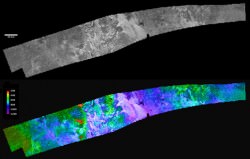[/caption]
Hang on, and enjoy a virtual flyover of Saturn’s moon Titan! Data from Cassini’s radar instrument have been used to create new flyover maps of Saturn’s largest moon. The maps show the topography of Titan in 3-D, and illustrating the height of the 1,200-meter (4,000-foot) mountain tops, the north polar lake country, the vast dunes more than 100 meters (300 feet) high that crisscross the moon, and the thick flows that may have oozed from possible ice volcanoes. “These flyovers let you take in the bird’s-eye sweeping views of Titan, the next best thing to being there,” said Randy Kirk, from the Science Center at the U.S. Geological Survey, who created the maps.. “We’ve mapped many kinds of features, and some of them remind me of Earth. Big seas, small lakes, rivers, dry river channels, mountains and sand dunes with hills poking out of them, lava flows.” Click the image above to see one of the movies.
During its mission, Cassini plans to map more than three percent of Titan’s surface in 3-D. About 38 percent of Titan’s surface has been mapped with radar so far. On March 27, Cassini will complete its 52nd targeted flyby of Titan.
Kirk used some of the 20 or so areas where two or more overlapping radar measurements were obtained during 19 Titan flybys to create the 3. These stereo overlaps cover close to two percent of Titan’s surface. The process of making topographic maps from them is just beginning, but the results already reveal some of the diversity of Titan’s geologic features.
Click here for another flyover movie in color, showing a strip of Titan’s surface in 3-D.
High and low features are shown in unprecedented detail at about 2.4-kilometer (1.5-mile) resolution. The maps show some features that may be volcanic flows. These flows meander across a shallow basin in the mountains. One area suspected to be an ice volcano, Ganesa Macula, does not appear to be a volcanic dome. It may still have originated as a volcano, but it’s too soon to know for sure. “It could be a volcanic feature, a crater, or something else that has just been heavily eroded,” added Kirk.

The stereo coverage includes a large portion of Titan’s north polar lakes of liquid ethane and methane, which in previous images has shown changes in lake size over time. Based on these topographical models, scientists are better able to determine the depth of lakes. The highest areas surrounding the lakes are some 1,200 meters (about 4,000 feet) above the shoreline. By comparing terrain around Earth to the Titan lakes, scientists estimate their depth is likely about 100 meters (300 feet) or less.
More 3-D mapping of these lakes will help refine these depth estimates and determine the volume of liquid hydrocarbons that exist on Titan. This information is important because these liquids evaporate and create Titan’s atmosphere. Understanding this methane cycle can provide clues to Titan’s weather and climate.
Source: JPL


Hydorcarbon lakes, methane rain, Ice volcanos…. these are far closer to the norm in our galaxy than anyting we find on Earth. Makes you realise what a special place our own planet is
It is good to be careful and use the term ‘possible’ ice volcanos; I’m not sure how certain it is that the lakes are depthy hydrocarbons.
It would be nice to know what everything else on Titan is made of, too.
Imagine what Christian Huygens would have thought about this!
Titan will be the first of many ice worlds that will be shown to have life. Mark my words! Ain’t it great to have been audience to the beginning of the “Great Age of Astronomy”?
Simeon, we just don’t know our galaxy enough to make that assumption. We’re just starting to get to know exoplanets, and I’m sure we will find many earthlike exoplantets in the near future.
With reference to the comments of ‘Fst’ and ‘Simeon’ above:
The exoplanet search is only just beginning! In the last 15 years, the count of such objects has risen from 3 to nearly 350 in the catalogue; it can be confidently asserted that with the improving techniques, methods and ground/space-based telescopes coming on-line, this number should reach/exceed 1,000 by 2010 – and will get up to 10,000 or 100,000 by 2020. with a search domain of this magnitude, statistics become more meaningful – and it will become possible to establish what constitutes the Galactic “norm” for planets and moons. Indeed it may then be possible to establish the “specialness” rating of planet Earth – or even whether we are unique or not!